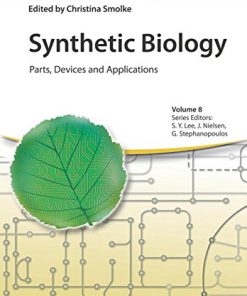Synthetic Biology Analysed Tools for Discussion and Evaluation 1st Edition by Margret Engelhard ISBN 3319797417 9783319797410
$50.00 Original price was: $50.00.$25.00Current price is: $25.00.
Synthetic Biology Analysed Tools for Discussion and Evaluation 1st Edition by Margret Engelhard – Ebook PDF Instant Download/Delivery: 3319797417, 978-3319797410
Full download Synthetic Biology Analysed Tools for Discussion and Evaluation 1st Edition after payment

Product details:
ISBN 10: 3319797417
ISBN 13: 978-3319797410
Author: Margret Engelhard
Synthetic Biology Analysed Tools for Discussion and Evaluation 1st Table of contents:
1. The New Worlds of Synthetic Biology—Synopsis
- Abstract
1.1 Attraction of Synthetic Biology
1.2 A Mosaic-like Field on the Move
1.3 Challenges to the Societal and Ethical Evaluation
1.4 Relevant Features and Concepts of Synthetic Biology
1.5 Layer Model
1.6 Challenge to the Concept of “Life”
1.7 Ethical Evaluation
1.8 Synthetic Biology as an Object of Public Perceptions
1.9 Legal Challenges- 1.9.1 Law Enabling and Regulating Synthetic Biology
- 1.9.2 Law Fostering Synthetic Biology
- 1.9.3 Law Ensuring Benefit Sharing
1.10 Outlook
- References
2. Synthetic Biology: Diverse Layers of Life
- Abstract
2.1 Introduction
2.2 The Main Research Agendas of Synthetic Biology- 2.2.1 The Engineering Branch of Synthetic Biology
- 2.2.2 Orthogonal Biology
- 2.2.3 Protocell Biology—Recapitulation of Evolution
2.3 A Layer Model to Describe and Classify Natural and Synthetic Organisms - 2.3.1 Layer of Genetically Modified and Artificially Designed Cells
- 2.3.2 Layer of Orthogonal Cells (Xenobiology)
- 2.3.3 Layer of Simple Life Forms and Protocells
2.4 Conclusions
- References
3. Old and New Risks in Synthetic Biology: Topics and Tools for Discussion
- Abstract
3.1 Synthetic Biology in the Risk Discussion- 3.1.1 Background: The Mosaic-like Structure of the Field
- 3.1.2 Dichotomy of the Attributes Novelty and Continuity
- 3.1.2.1 Novelty in the Synthetic Biology Context
- 3.1.2.2 Invalidity of the “Continuity Argument” in Risk Evaluation
- 3.1.3 Scope of Synthetic Biology Politicized
- 3.1.4 Differentiating Development Time and Speed
3.2 Levels of the Risk Discussion
3.3 New Features Relevant for Risk Evaluation - 3.3.1 Depth of Intervention, Complexity, and Predictability
- 3.3.1.1 Depth of Intervention
- 3.3.1.2 Predictability: Safety Concepts of Synthetic Biology
- 3.3.2 Risk Assessment Challenges: Familiarity Principle and Speed of Developments
3.4 Special Cases in Risk Assessment - 3.4.1 “The Farther, the Safer”?
- 3.4.2 Sense Codon Reassignment in the Genetic Code
- 3.4.2.1 Natural Background
- 3.4.2.2 Adaptive Features
- 3.4.2.3 Technological Risks and Benefits
- 3.4.3 The Innocence of Protocells
3.5 Summary and Outlook
- References
4. The Concept of Life in Synthetic Biology
- Abstract
4.1 Four Episodes in the History of Artificial Life Research
4.2 Modes of Artificiality in Artificial Life Research
4.3 Artificial Systems as Models for Living Systems
4.4 Modes of Vitality in Artificial Life Research
4.5 Can Artificially Designed Systems Be Instantiations of Life? - References
5. New Debates in Old Ethical Skins
- Abstract
5.1 Ethics of Technology
5.2 Synthetic Biology—A Philosophical View- 5.2.1 Synthetic Biology as a Climax of Modern Science and Technology
- 5.2.2 The Ethical Relevance of Synthetic Biology
5.3 Ethical Issues of Synthetic Biology - 5.3.1 Does Synthetic Biology Need a New Ethics?
- 5.3.2 Risk
- 5.3.3 Global Justice
- 5.3.4 The ‘Playing God’ Argument
- 5.3.5 Acting Under Uncertainty
- 5.3.6 New or Old Ethics?
5.4 The Need for New Ethical Debate and Its Problems - 5.4.1 The Need for Debate
- 5.4.2 Lack of Public Debate
- 5.4.3 Conceptual Challenges for Ethicists
- 5.4.4 The Silence of the Labs?
- 5.4.5 Scientific and Public Language
5.5 The Three Moral Laws - 5.5.1 A Moral Proposal
- 5.5.2 First Law: A Biotic Artefact May Not Injure a Human Being
- 5.5.3 Second Law: A Biotic Artefact Must Be Strictly Functional
- 5.5.4 Third Law: A Biotic Artefact Must Be Protected
- 5.5.5 Short Conclusion
- References
6. Synthetic Biology: Public Perceptions of an Emergent Field
- Abstract
6.1 Introduction
6.2 The Space and Role of Public Perceptions of Emergent Technoscientific Areas
6.3 Resistance to Science as a Function of Lack of Knowledge
6.4 Changes in Institutional and Cultural Frameworks for New Sciences
6.5 Positive Attitudes to Science and Reservations About Biotechnology
6.6 Public Views on Synthetic Biology- 6.6.1 Low Salience and Public Views
- 6.6.2 Early U.S. Perceptions of Synthetic Biology
- 6.6.3 European Perceptions of Synthetic Biology
- 6.6.3.1 Awareness in Europe
- 6.6.3.2 Criteria for Evaluation
- 6.6.3.3 Global Acceptance Positions
- 6.6.3.4 Regulatory Regimes
- 6.6.4 Unnaturalness and “Playing God”
6.7 Conclusion
- References
7. In Search of a Legal Framework for Synthetic Biology
- Abstract
7.1 Introduction
7.2 Enabling and Regulating Synthetic Biology- 7.2.1 Constitutional Freedoms and Regulation
- 7.2.2 Preventive Administrative Regulation
- 7.2.2.1 Applicability of GMO Regimes to Synthetic Biology
- 7.2.2.2 Adequacy of GMO Regimes
- 7.2.3 Regulation Ex Post
- 7.2.4 Conclusion
7.3 Promoting Synthetic Biology via Intellectual Property - 7.3.1 Patenting Life Forms
- 7.3.2 Stimulus of Patents
- 7.3.3 Patent Law in Synthetic Biology
- 7.3.4 Copyright for Synthetic Biology Programs
7.4 Redistributing Benefits from Synthetic Biology
7.5 Summary
People also search for Synthetic Biology Analysed Tools for Discussion and Evaluation 1st:
systems biology modeling analysis and simulation
why is synthetic biology important
molecular biology dna analysis
data analysis biology definition
define synthetic biology
Tags:
Margret Engelhard,Synthetic,Biology,Analysed,Tools,Discussion,Evaluation 1st
You may also like…
Biology and other natural sciences
Biology and other natural sciences - Molecular
Synthetic Biology Omics Tools and Their Applications Shailza Singh
Engineering
Biology and other natural sciences
Politics & Philosophy - Social Sciences
Biology and other natural sciences
Science (General)
Synthetic biology Volume 2 1st Edition Maxim 1788014057 9781788014052












